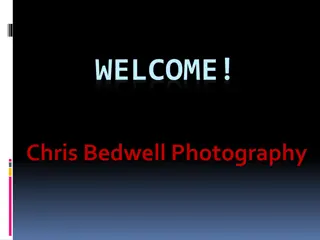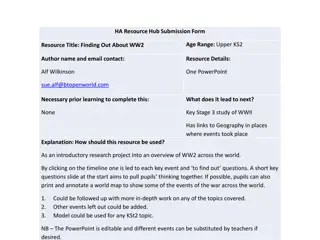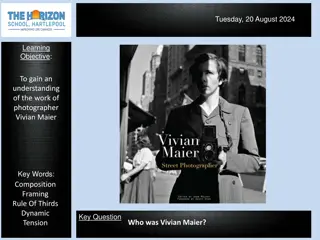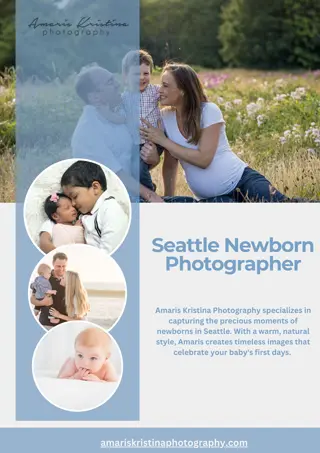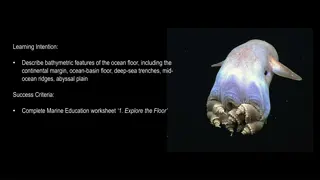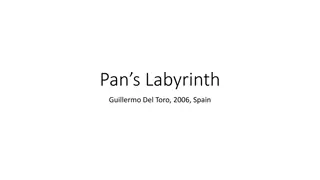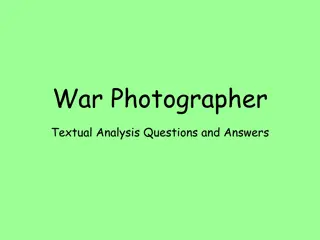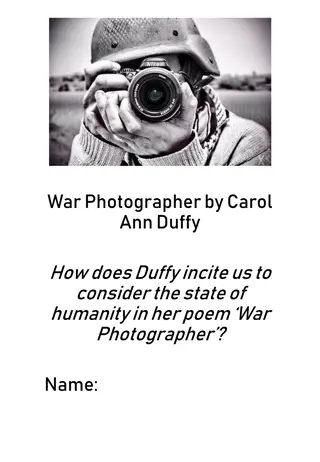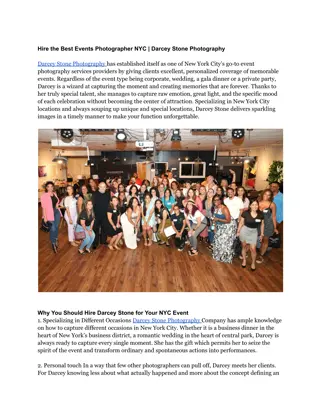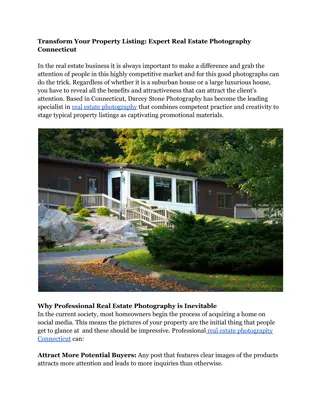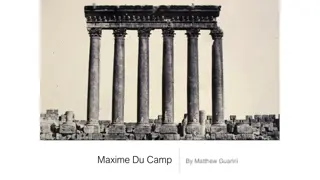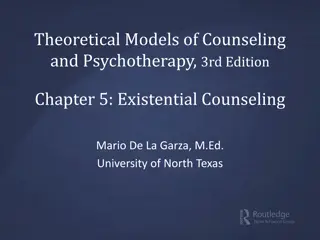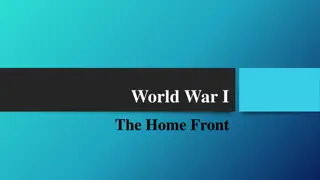Exploring the Depths of a War Photographer's Psyche
A contemplative analysis of a poem inspired by the challenging role of war photographers, their struggle to document atrocities, and the impact on their mental state. Through structured stanzas and metaphorical imagery, the poet invites reflection on our response to such images and the photographer's quest for order amidst chaos.
Download Presentation

Please find below an Image/Link to download the presentation.
The content on the website is provided AS IS for your information and personal use only. It may not be sold, licensed, or shared on other websites without obtaining consent from the author. Download presentation by click this link. If you encounter any issues during the download, it is possible that the publisher has removed the file from their server.
E N D
Presentation Transcript
Duffy was inspired to write this poem by her friendship with a war photographer. She was especially intrigued by the peculiar challenge faced by these people whose job requires them to record terrible, horrific events without being able to directly help their subjects. Duffy perhaps shares an affinity with these photo journalists - while they use the medium of photography to convey certain truths about the human condition, she uses words and language to do the same job. Throughout the poem, Duffy provokes us to consider our own response when confronted with the photographs that we regularly see in our newspaper supplements, and why so many of us have become desensitised to these images. By viewing this issue from the perspective of the photographer, she also reveals the difficulties of such an occupation. By the end of the poem, it is clear her subject straddles two vastly different worlds yet increasingly feels he belongs to neither.
Form and structure The poem is laid out in four regular six-line stanzas, with each stanza ending in a rhyming couplet. This structure is interesting since its very rigid order contrasts with the chaotic, disturbing images described in the poem. This organisation mirrors the actions of the photographer, who lays out his films in ordered rows, as though in doing so he can in some way help to restore order to this chaotic world. The poem moves through a series of observations in the first three stanzas to a conclusion of sorts in the fourth. The style is almost clinical and matter of fact, perhaps to imitate the detached approach required by people in this line of work to allow them to do their jobs under extreme pressure. Unlike the readers of the newspaper he works for, this sense of distance is a necessary requirement for the photographer. Unsurprisingly, in a poem that is so focused on images of human suffering, Duffy concentrates on the sense of sight throughout the poem and the final image is almost like a photograph itself, depicting the journalist surveying the landscape and its inhabitants below impassively as he travels to his next assignment.
Metaphor - comparing actual dark room for developing photos with his state of mind Alone at the end of the line conveys his relief along with the word finally which has connotations of longing for this solitude intimate, dark, tranquil setting In his dark room he is finally alone with spools of suffering set out in ordered rows. The only light is red and softly glows, Metaphor - Spools are long, strips of film which are cyclical in a camera. Suggesting that this man s pain is long and never ending. The word suffering reinforces his distress. Word choice of Red connotations of the light that burns continuously in Catholic churches to symbolise the presence of Christ and also of blood a sight that the photographer must be all too familiar with. Ordered rows suggest he is attempting to restore order to the chaotic images. This is mirrored in structure poem is set out in distinct stanzas.
Just as a religious or spiritual person may look for the same kind of solace in a church had they been confronted with the same horrors that the photographer must endure. A mass also has deeper meaning. A priest tries to get an important message across, so does the photographer through his vocation. They are also linked with their associations with death. as though this were a church and he a priest preparing to intone a Mass. Belfast. Beirut. Phnom Penh. All flesh is grass Biblical allusion all flesh is grass comes from the scriptures and reinforces the religious imagery as well as emphasizing the fragility and transient nature of life. we all return to the same earth when we die. Sentence structure short, single word sentences - emphasising the varied areas of contrast, its widespread nature.
Blunt Statement makes a clear point, no argument. The business like, professional attitude is what he brings to his job. Literal chemical solutions used to develop the photos. Metaphorical The photos themselves are possible solutions. They might open people s eyes and stop war. *(soft sound created by sibilance/ assonance) Word choice then when he was taking the photos his hands tremble because of adrenaline, his sense of duty takes over. He is detached. Now he is reflecting on what he has actually witnessed. He has a job to do. Solutions slop in trays beneath his hands, which did not tremble then though seem to now. Rural England. Home again Means countryside. The connotations are of fields, peacefulness, tranquillity. This creates a clear Contrast between home and the warzone
The juxtaposition of these 2 words suggests just how trivial and insignificant the problems of British people are compared to those in war zones. British people's problems can be solved by the weather being nice and sunny again emphasizing the contrast between their lives and those in life in constant conflict. Word choice don t is a deliberate attempt by Duffy to highlight that there are many places where this does happen. to ordinary pain which simple weather can dispel, to fields which don t explode beneath the feet of running children in a nightmare heat. Warzones are arid, dusty, exotic contrast with rural England. Nightmare also literal nightmare of bad dream, waking up in a sweat has this happened to photographer? The effect is that it almost seems a rarity when children are safe in the fields in which they play. This is how he sees it. Contrast and double meaning of Running in warzone due to fear, here they are playing. Children are innocent that makes it more emotive.
Word choice something makes it a mysterious, blank statement intrigues the reader. It also shows us the photographer is not fully in control of the development process . Duffy allows us to see the horrific image develop in front of our eyes. Also adds to mystery. Conveys the mass nature of death in war -nobody is known intimately, everyone is anonymous. Something is happening. A stranger s features faintly start to twist before his eyes, a half-formed ghost. He remembers the cries Metaphor Literal slowly developing photo, not fully developed, gradually appearing Metaphorical the subject is now dead, are they dying as the picture is being taken. Is this why they are a half formed ghost? Even after the event the sound lingers with him, permanently remembered, distresses the photographer. Memory haunts the war photographer.
Word choice - implies trying to do the right thing, sought doesn t necessarily mean he got the approval but he has a job to do. Language barrier but also to emotional/upset of this man s wife, how he sought approval without words to do what someone must and how the blood stained into foreign dust. Word choice literally bleeding, metaphorically stains don t come out the events will stay with photographer and wife forever. Foreign dust setting here from abroad, an exotic place.
Literally black-and-white, metaphorically good and evil? Contrast between hundred and five or six so what people see is only a small fraction. The careless indifference in the way the editor selects the images reinforces how little regard we have for the subjects in the pictures. A hundred agonies in black and white from which his editor will pick out five or six for Sunday s supplement. The reader s eyeballs prick Just as a prick would be a brief, forgettable pain, this is the same feeling with which these citizens sympathise/ care for the casualties of war. Not the main news, an additional thing.
The Rhyme of tears beers, and alliterative B sound emphasises the minimal effect, their sorrow is sandwiched between two leisure activities. The use of Bathos - an effect of anticlimax created by a lapse in mood from the sublime to the trivial or ridiculous is effective with tears between the bath and pre-lunch beers. From the aeroplane he stares impassively at where he earns his living and they do not care. "they", emphasising how little he identifies with British lives and values. As he surveys the landscape of rural England from the aeroplane, there is a growing acceptance that, despite his best efforts, his photographs will ultimately make no real difference Numb, given up, emotionless.
The poem focuses on two main themes: the horror of war our increasing indifference to the victims of conflict These themes are revealed not only through Duffy s word choice and imagery, but also through the central paradox that while the imagery of war is more widespread and prevalent than at any other time in history, its impact upon those of us exposed to it is rapidly declining. .
The horror of war Duffy s skilful yet understated imagery helps to convey the terrible personal stories that lie behind every conflict. Perhaps almost in an attempt to counter the graphic imagery that we have become so used to seeing, her depictions are subtle and understated and she often leaves the reader to compose their own images. For example, in the line to fields which don t explode beneath the feet /of running children, she takes an image that we would usually associate with something innocent and happy and subverts it into something much more sinister. Similarly, her description of the dying man contains almost no visual imagery and instead focuses on the sense of sound through the word choice cries and the unspoken communication between the photographer and the victim s wife By focusing on just one image rather than the countless others that were taken, Duffy forces us to confront the personal cost of war. In doing so, Duffy again exposes another paradox inherent in the coverage of modern conflict, implying that we have lost the capacity to view the subjects of war as real human beings, each with unique, individual stories and tragedies
Our increasing indifference to the victims of conflict Throughout the poem, Duffy conveys the increasing separateness and isolation the photographer feels both towards his own country and the newspaper he works for. Unlike us and his editor, he is unable to protect himself from the horror of the subjects he photographs and there is a sense of growing bitterness as he continues to feed the voracious need for news in the knowledge that we are increasingly unmoved and unaffected by the images. Our disingenuous response is recorded most clearly in the line The reader s eyeballs prick/with tears between the bath and pre-lunch beers. His contempt for his editor is revealed in the careless, thoughtless way he notes how he chooses photographs for the paper, picking out five or six/for Sunday s supplement. Ironically, in an almost parallel response to our desensitisation, the photographer too feels increasingly indifferent towards his homeland and fellow countrymen as he stares impassively at where/he earns his living and they do not care.
War Photographer by Carol Ann Duffy Learning Intentions - To examine the effect of different examples of war photography To examine Carol Ann Duffy s message behind her poem War Photographer -
War Photographer by Carol Ann Duffy Starter: In groups, discuss the following questions and be prepared to share your ideas with the class. 1) What do we often see in images from war zones? 2) Why do you think those in charge of newspapers/TV decide to show images from war zones? 3) What do you think it would feel like to be a war photographer ? 4) How might a war photographer feel about the value of the job they are doing?
War Photographer by Carol Ann Duffy Examples On the next few slides you will see some examples of images from different war zones. We shall discuss the focus of each photograph what are we drawn to? For each photograph, you should think about how you are made to feel. You should then think about what the photographer would have been going through as they took the photo.
War Photographer by Carol Ann Duffy After Reading - Discussion: Do you think Duffy s poem is pro or anti-war photography? How do you think this photographer feels about their job? Pride or guilt? How do you think Duffy feels towards the newspaper editors? What does Duffy seem to be suggesting about the way the readers react to seeing these images? What is Duffy trying to point out about life in Britain compared to Beirut etc?
War Photographer by Carol Ann Duffy Learning Intentions - To understand the background of the different conflicts alluded to in the poem War Photographer To identify a range of techniques used by Carol Ann Duffy in War Photographer To identify the tone(s) in War Photographer - To begin a more detailed analysis of techniques -used in War Photographer - -
War Photographer by Carol Ann Duffy Poem Analysis First Step Underline the words/phrases which you think are important. If you identify any techniques, write the term in pencil at the end of the line. Once complete, think about the overall tone of this poem. You might use a few words to describe the tone at different points in the poem. Make sure that you have highlighted all the words which help establish this tone.
War Photographer by Carol Ann Duffy Developing Analysis When you are writing about this poem you will have to explain why you think each technique has been used. Think what does it suggest or show. You may wish to record your ideas in a table
Quotation Literal Meaning Idea/Emotion Suggested darkroom (Word choice) Literally, the room for developing photographs Connotations of a serious, brooding, bleak, grim place: perhaps suggest the job takes the photographer to a dark place mentally: anxiety, stress and horror. finally alone (Word choice) The war photographer is alone. Photographer is seeking solace; possibly trying to escape something perhaps guilt/memories. spools of suffering set out in ordered rows (Alliteration, Assonance, Word choice/ Imagery) Reel of pictures taken in war zone. Photos have captured and taken on the pain of those in the picture. The spools themselves now represent something agonising to the photographer. Repetition of the s and o mirrors the repetitive, meticulous arrangement of the canisters of film. There is the sense the photographer is trying to create order/ meaning from the chaos of war. The ordered rows brings to mind the image. Perhaps, of rows of tombstones. Including the adjective ordered emphasises the photographer s methodical, robotic way of working.
War Photographer by Carol Ann Duffy Learning Intentions - To understand the techniques for answering different type of textual analysis questions on poetry
War Photographer by Carol Ann Duffy Critical Reading Questions The following slides have example answers for the Critical Reading questions you have completed. The answers are not the ONLY ones available. But hopefully they will give you an idea of what will be expected in the exam.
War Photographer by Carol Ann Duffy Critical Reading Questions 1a) Many of the main ideas or concerns of the poem come across clearly in the first stanza. Suffering/ The effects of war (1) Dealing with the emotional impact of war (1) Identify two of these main ideas or concerns from stanza one. (2) The job/ role/ experience of the war photographer (1)
War Photographer by Carol Ann Duffy Word choice darkroom (1) reflects the troubled state of mind the photographer has because of his experiences of war (1) 1b) Show how two examples of the poet s use of language in stanza one help to clarify or illustrate his meaning. You should refer to two of word choice, structure or imagery (4) finally alone - word choice (1) suggests that the photographer has been longing to be on his own, perhaps because of the traumatic experiences he has had doing his job (1) with spools of suffering metaphor (1) suggesting the endlessness of the misery the photographer has witnessed (1) ordered rows word choice (1) suggests the idea that the photographer is trying to make sense or create order from the senseless war. (1)
War Photographer by Carol Ann Duffy the only red light is red and softly glows - word choice red (1) suggests the hate and anger involved in war, making us think of those who have suffered (1) 1b) Show how two examples of the poet s use of language in stanza one help to clarify or illustrate his meaning. You should refer to two of word choice, structure or imagery (4) red light (1) word choice reminds us of a sanctuary light in a church and suggests the photographer is (1) as though this were a church or a priest preparing to intone a mass imagery suggests (1) the photographer is reflecting on the memories of those who have died/ has a duty to reflect on the suffering. (1) all flesh is grass (1) biblical imagery (metaphor) making us think of the transient nature of life particularly in war (1)
War Photographer by Carol Ann Duffy He has a job to do. This short, simple sentence placed at the start of the line (structure) (1) creates the effect that he has no other choice/ that he must remain detached from his work (1) 2.Show how any three examples of the poet s use of language in stanza two effectively contribute to the main ideas or concerns of the poem. You should make reference to imagery, word choice and one other technique. (6) Solutions slop word choice (1) reveals the idea in the poem that there are no simple, easy resolutions to war. (1) ordinary pain Oxymoron (1) reveals the idea that the discomfort experienced by people in England are trivial compared with those who suffer at war. Pain cannot be ordinary (1) fields which don t explode Shocking imagery (1) again revealing the contrast between peaceful home of photographer and violent war torn countries he has visited. (1)
War Photographer by Carol Ann Duffy Something is happening. Ambiguous word choice (1) suggests picture appearing on photo, but also that the photographer is having an emotional response to the horror he has seen. (1) 3.With reference to word choice and imagery, explain how the poet conveys their ideas in stanza 3 of the poem. (4) faintly start to twist -Word choice twist (1) implies the pain and suffering felt by the person in the photo (the look of pain on their face)(1) half formed ghost imagery (1) We imagine an picture beginning to appear. However, description is also a metaphor for the soul of the person in the photo it is implied they have died. (1) remembers the cries/ blood stained into foreign dust Word choice (1)cries and stained appeal to different senses showing impact of war on photographer. (1)
War Photographer by Carol Ann Duffy A hundred agonies - Word choice (1) emphasises the vast number that have suffered which sums up the idea of the pain caused by war. (1) 4. How effective do you find any aspect of the final stanza as a conclusion to the poem? Your answer should deal with ideas and and/or language. (4) pick outfive or six for Sunday s Supplement (1) Duffy sums up her criticism of the editors of newspapers who trivialise the suffering of war to sell papers pick out suggests some are more important than others. Supplement suggests news item is not important. (1) prick with tears - Word choice (1) sums up Duffy s criticism of the readers reaction to photos they only care for a moment. (1) Between the bath and pre-lunch beers as above readers quickly forget photos as they indulge in luxuries (1)
4. How effective do you find any aspect of the final stanza as a conclusion to the poem? Your answer should deal with ideas and and/or language. (4) stares impassively word choice(1) Sums up impact of job on photographer he feels disconnected from people in his own country as they do not care (1)



